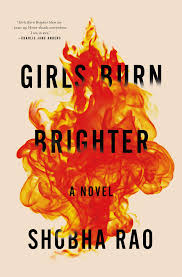
News
Summers Will Not Finish Semester of Teaching as Harvard Investigates Epstein Ties

News
Harvard College Students Report Favoring Divestment from Israel in HUA Survey

News
‘He Should Resign’: Harvard Undergrads Take Hard Line Against Summers Over Epstein Scandal

News
Harvard To Launch New Investigation Into Epstein’s Ties to Summers, Other University Affiliates

News
Harvard Students To Vote on Divestment From Israel in Inaugural HUA Election Survey
‘Girls Burn Brighter’: A Sober Reminder of the Reality Many Women Face
4.5 Stars

Shobha Rao’s debut novel “Girls Burn Brighter” begins with a heart-wrenching tragedy, but is not the cause of the numerous horrors that follow. While hard to stomach, the abuses depicted in the novel make for a powerful and unforgettable narrative. In the small South Indian village of Indravalli, a mother falls ill with cancer and passes away. Her daughter, Poornima is now left to the whims of her cruel father who, after the year mourning period, seeks to marry Poornima off.
During this year-long reprieve, Poornima’s father hires Savitha, an impoverished weaver who functions as her family’s main breadwinner. The deep and moving friendship that Poornima and Savitha develop serves as a brief period of light in these women’s intensely dark tales. Once separated, these women face unspeakable cruelties at the hands of not only individual men, but also a society which sees them as little more than objects for public use. Rao powerfully describes a woman’s exploitation and abuse as “a deal, a deal for her body: first for its blooming and then for its wilting; first for her bleeding and then for her virginity and then for her bearing (counting only the sons) and then for her widowing.”
Rao’s novel is as moving as it is infuriating. Through a series of heinous and tragically common abuses, Poornima and Savitha are literally and metaphorically mutilated by society. Though external forces rob the girls of their virginity, their skin, their limbs, and so much more, Rao powerfully writes of how this abuse leads to the loss of something even more essential. Noticing the cold, dead gaze of a girl forced into prostitution, Poornima mournfully notes that “the girl had lost her sense of light.” Though readers may find the sheer scope of tragedy in “Girls Burn Brighter” overwhelming, the crimes which Rao describes are all too common.
Poornima and Savitha’s remarkable inner fires, fueled by their friendship and resistant to the crimes of men, uplifts and inspires. However, the crimes the girls endure at the hands of malicious men inspire not hope, but rage. Each page of Rao’s novel brings forth a new assault, whether it be violent or verbal, sexual or political, implicit or explicit against the very existence of these women. This is not a casual read, one of light fun or carefree entertainment. It is a horrifying, angering, and disgusting book. The novel inspires fury. But it is a fury that needs to be felt.
However, like Rao’s characters, so many women have fought through the systems and the individuals who oppress them. On March 8, hundreds of millions around the world celebrated International Women's Day. Rao’s book reminds that the day is not about upside down McDonald’s arches or gendered bottles of Johnnie Walker, but about survivors, pioneers, and allies, about marches, rallies, and demonstrations. “Girls Burn Brighter” is a reminder of the horrors women still endure today, and the unique strength these women have.
—Staff writer Raj Karan S. Gambhir can be reached at raj.gambhir@thecrimson.com
Want to keep up with breaking news? Subscribe to our email newsletter.
